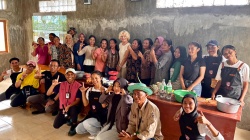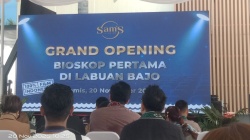Labuan Bajo | Okebajo.com | The Manggarai Barat Regency Government, through the Department of Tourism, Creative Economy, and Culture, held the launching ceremony for the Wae Lolos Tourism Village in Sano Nggoang District, Manggarai Barat Regency, East Nusa Tenggara on Wednesday, December 18, 2024.
The Head of the Department of Tourism, Creative Economy, and Culture of Manggarai Barat Regency, Stefanus Jemsefori, emphasized that Labuan Bajo’s status as a Super Priority Destination is not limited to the Komodo National Park and its waters. Moreover, the Manggarai Barat Regency government is seriously committed to managing the mainland tourism in existing tourism villages that possess rich natural, cultural, and traditional art resources for the sake of local community independence and increased welfare.
“We, the regional government, supported by various stakeholders with their respective roles, have a vision that the DSP status held by Manggarai Barat today is not only about the Komodo National Park, not only about diving and snorkeling or witnessing the beauty of the waters. We are also seriously committed to the independence of tourism villages that have the potential for cultural tourism and traditional arts,” Stefan emphasized.
As a form of support from the regional government, the Department of Tourism, Creative Economy, and Culture in 2024 implemented an innovation program, namely the Facilitation of Tourism Village Communities (Fasmadewi) in two tourism villages out of 94 tourism villages spread across Manggarai Barat Regency. According to Stefan, the purpose of the Fasmadewi program is to increase the capacity and competence of human resources (HR) in tourism villages so that they can provide quality tourism experiences for tourists.
“We need to know together that there are 94 tourism villages in Manggarai Barat. However, the villages we chose for the Fasmadewi program this year are only two villages, namely Wae Lolos and Siru Village,” said Stefan.
He said that the determination of these two tourism destinations as targets for the Fasmadewi program was not due to close relations or vested interests but had a basis, namely the support and enthusiasm of the community (bottom-up).
“We see in Wae Lolos that the community and its village government are enthusiastic. Congratulations and appreciation to Mr. Robert Perkasa as the Head of the Tourism Awareness Group and Mr. Albert who is extraordinary in packaging promotions and marketing through social media. Long before there was any touch from the regional government, any touch from the Department of Tourism, Creative Economy, and Culture, Mr. Robert and his colleagues had been conducting massive promotions and marketing through social media. Wae Lolos is already known internationally. This is evidenced by the data on the number of domestic and foreign tourists visiting Wae Lolos in 2024, which reached 11,000 people. Wae Lolos is extraordinary,” said Stefan.
With this spirit, Stefan said, the regional government is truly aware that the Manggarai Barat Department of Tourism, Creative Economy, and Culture cannot work alone in efforts to manage these tourism villages. They need the support of all stakeholders with their respective roles.
“Just look today, we came to Wae Lolos alone. We also brought in tourism industry partners because they are the ones who are with the tourists every day. We also brought partners from academia, the police, and the military, together with the sub-district government. This indicates the seriousness of the regional government in providing support and assistance for the independence of tourism villages. Today we come to Wae Lolos. Maybe tomorrow or the day after we will come to other tourism villages and Wae Lolos village will become a resource person for the tourism villages that we will then touch. That is roughly our big motivation and spirit,” he said.
Concluding his remarks, Stefan said that the government is a public servant who needs the support of stakeholders with their respective roles in advancing tourism in Manggarai Barat, especially in tourism villages. Managing tourism villages cannot be done by the regional government alone; it requires collaboration with all stakeholders.
“For Wae Lolos to progress further in the future, let us all work together. Especially to friends in the tourism industry who are members of HPI, Assita, Astindo, travel agent communities, transportation communities, etc., let us with our respective roles help the regional government, help Wae Lolos village. We, the government, are only servants. We, as servants, are said to be successful if the community changes from bad to good, from sufficient to prosperous. If that doesn’t happen, then we have failed as servants,” said Stefan.
A Historic Moment
The Head of the Cunca Plias Tourism Awareness Group (Pokdarwis), Robert Perkasa, said the launching of the Wae Lolos Tourism Village was a historic moment.
Robert hopes that in the future, Wae Lolos Tourism Village will be visited by more tourists, thus impacting the improvement of the local community’s economy.
“Hopefully, with the existence of this tourism village, the welfare of the surrounding community will continue to increase and Indonesian tourism will become more well-known worldwide. With the launching of the Wae Lolos Tourism Village in the Langgo traditional village, we hope to introduce the natural beauty and cultural wealth of Indonesia to the world,” he said.
Wae Lolos Tourism Village can be reached from Labuan Bajo within an hour’s drive and has good road access. This village is often nicknamed the ‘Thousand Waterfalls’ tourism village because there are many waterfalls that tourists can enjoy there.
“We offer seven natural tourism spots, namely Cunca Plias One Waterfall, Cunca Plias Two Waterfall, Tiwu Galong Waterfall, Above the Clouds Pool and Cunca Ri’i Waterfall, Cunca Liang Langgo, Cunca Wongka, Cunca Lolos, and other natural tourist spots. Wae Lolos is ready to welcome tourists and amaze the world. Let us preserve our nature and culture,” said Robert.
















